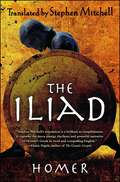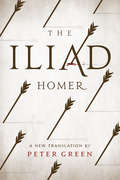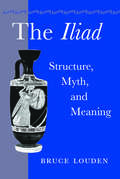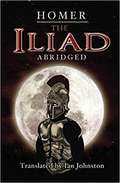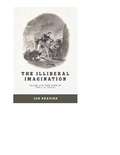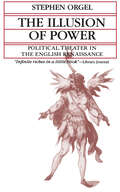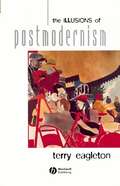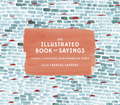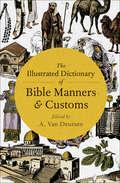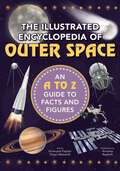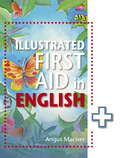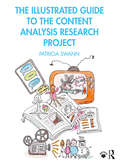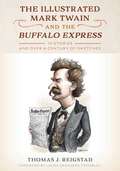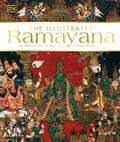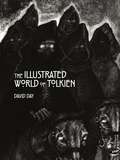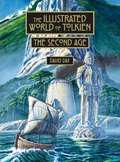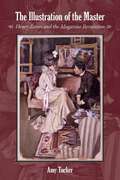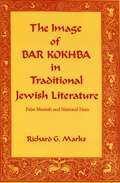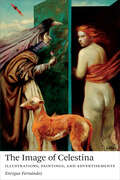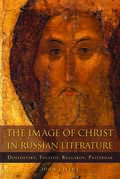- Table View
- List View
The Iliad: (The Stephen Mitchell Translation)
by Homer Stephen MitchellTOLSTOY CALLED THE ILIAD A miracle; Goethe said that it always thrust him into a state of astonishment. Homer’s story is thrilling, and his Greek is perhaps the most beautiful poetry ever sung or written. But until now, even the best English translations haven’t been able to re-create the energy and simplicity, the speed, grace, and pulsing rhythm of the original. In Stephen Mitchell’s Iliad, the epic story resounds again across 2,700 years, as if the lifeblood of its heroes Achilles and Patroclus, Hector and Priam flows in every word. And we are there with them, amid the horror and ecstasy of war, carried along by a poetry that lifts even the most devastating human events into the realm of the beautiful. Mitchell’s Iliad is the first translation based on the work of the preeminent Homeric scholar Martin L. West, whose edition of the original Greek identifies many passages that were added after the Iliad was first written down, to the detriment of the music and the story. Omitting these hundreds of interpolated lines restores a dramatically sharper, leaner text. In addition, Mitchell’s illuminating introduction opens the epic still further to our understanding and appreciation. Now, thanks to Stephen Mitchell’s scholarship and the power of his language, the Iliad’s ancient story comes to moving, vivid new life.
The Iliad: A New Translation by Peter Green
by HomerOne of the oldest extant works of Western literature, the Iliad is a timeless epic poem of great warriors trapped between their own heroic pride and the arbitrary, often vicious decisions of fate and the gods. Renowned scholar and acclaimed translator Peter Green captures the Iliad in all its surging thunder for a new generation of readers. Featuring an enticingly personal introduction, a detailed synopsis of each book, a wide-ranging glossary, and explanatory notes for the few puzzling in-text items, the book also includes a select bibliography for those who want to learn more about Homer and the Greek epic. This landmark translation--specifically designed, like the oral original, to be read aloud--will soon be required reading for every student of Greek antiquity, and the great traditions of history and literature to which it gave birth.
The Iliad: Structure, Myth, and Meaning
by Bruce LoudenExtending his distinctive analysis of Homeric epic to the Iliad, Bruce Louden, author of The "Odyssey": Structure, Narration, and Meaning, again presents new approaches to understanding the themes and story of the poem. In this thought-provoking study, he demonstrates how repeated narrative motifs argue for an expanded understanding of the structure of epic poetry. First identifying the "subgenres" of myth within the poem, he then reads these against related mythologies of the Near East, developing a context in which the poem can be more accurately interpreted.Louden begins by focusing on the ways in which the Iliad's three movements correspond with and comment on each other. He offers original interpretations of many episodes, notably in books 3 and 7, and makes new arguments about some well-known controversies (e.g., the duals in book 9), the Iliad's use of parody, the function of theomachy, and the prefiguring of Hektor as a sacrificial victim in books 3 and 6. The second part of the book compares fourteen subgenres of myth in the Iliad to contemporaneous Near Eastern traditions such as those of the Old Testament and of Ugaritic mythology. Louden concludes with an extended comparison of the Homeric Athena and Anat, a West Semitic goddess worshipped by the Phoenicians and Egyptians. Louden's innovative method yields striking new insights into the formation and early literary contexts of Greek epic poetry.
The Iliad: Translated By Ian Johnston
by Homer Ian JohnstonHomer's Iliad, the oldest and greatest epic poem in our culture, was composed in the eighth century BC. It became the single most important literary resource in ancient Greek culture, and has exercised a decisive influence on Western culture an influence which continues to this day. The poem tells the story of a quarrel between Achilles, the greatest of the Achaean warriors in the Greek expedition against Troy, and Agamemnon, the commander of the expedition an argument which causes Achilles to withdraw from the fighting. The battles continue without him, and the ironic unfolding of events eventually leads him to rejoin the war and to seek out the great Trojan warrior Hector for a climactic single combat. The Iliad is our most important war poem. It constantly forces us to confront what goes on in battle, how men sustain themselves amid the horrors of the killing zone, and how the activity is simultaneous intensely and brutally destructive and also, by one of the strangest of all of life's ironies, intensely creative. Ian Johnston's abridged version of Homer's great poem is based upon his acclaimed translation of the complete epic (also published by Richer Resources Publications). The abridged text is approximately one third of the original and presents a coherent narrative poem in which every line is taken from Homer's text, with occasional short summaries to keep the story coherent. This shortened version is an ideal entry into Homer's vision of the world for those who are not yet ready or do not have the time to tackle the full poem. The text is accompanied by a few explanatory footnotes, a glossary of names, and a map indicating the origin of many of the major characters.
The Iliad: a commentary
by G. S. KirkThis, the fourth volume in the six-volume Commentary on The Iliad being prepared under the General Editorship of Professor G. S. Kirk, covers Books 13-16, including the Battle for the Ships, the Deception of Zeus and the Death of Patroklos. Three introductory essays discuss the role of Homer's gods in his poetry; the origins and development of the epic diction; and the transmission of the text, from the bard's lips to our own manuscripts. It is now widely recognised that the first masterpiece of Western literature is an oral poem; Professor Janko's detailed commentary aims to show how this recognition can clarify many linguistic and textual problems, entailing a radical reassessment of the work of Homer's Alexandrian editors. The commentary also explores the poet's subtle creativity in adapting traditional materials, whether formulae, typical scenes, mythology or imagery, so as best to move, inspire and entertain his audience, ancient and modern alike. Discussion of the poem's literary qualities and structure is, where possible, kept separate from that of more technical matters.
The Illiberal Imagination: Class and the Rise of the U.S. Novel
by Joe ShapiroThe Illiberal Imagination offers a synthetic, historical formalist account of how—and to what end—U.S. novels from the late eighteenth century to the mid-1850s represented economic inequality and radical forms of economic egalitarianism in the new nation. In conversation with intellectual, social, and labor history, this study tracks the representation of class inequality and conflict across five subgenres of the early U.S. novel: the Bildungsroman, the episodic travel narrative, the sentimental novel, the frontier romance, and the anti-slavery novel.Through close readings of the works of foundational U.S. novelists, including Charles Brockden Brown, Hugh Henry Brackenridge, Catharine Maria Sedgwick, James Fenimore Cooper, and Harriet Beecher Stowe, Joe Shapiro demonstrates that while voices of economic egalitarianism and working-class protest find their ways into a variety of early U.S. novels, these novels are anything but radically dialogic; instead, he argues, they push back against emergent forms of class consciousness by working to naturalize class inequality among whites. The Illiberal Imagination thus enhances our understanding of both the early U.S. novel and the history of the way that class has been imagined in the United States.
The Illusion of Power: Political Theater in the English Renaissance
by Stephen Orgel"Elegant, deeply learned, and intellectually adventurous, its implications extend far beyond the boundaries of the Stuart and Caroline masque. It is an indispensable, exploration of political art and aestheticized politics. . . . a classic."--Stephen Greenblatt, University of California, Berkeley "A triumph of scholarship, insight, and explication, Oregel's book is truly a classic in the field of Renaissance studies. Anyone interested in Renaissance culture will find here a masterful analysis of its celebration of royal power."--Coppelia Kahn, Brown University "As knowing of art, theatrical and political history as it is sensitive to poetry, Orgel's book is learned, lively, and beautifully clear."--John Hollander, Yale University "A foundational text for the New Historicist Perspective in English Renaissance literary and cultural studies . . . as informative and suggestive as it was when new; in the clarity and grace of its writing, the breadth and precision of its arguments, the aptness and resonance of its examples, it is unsurpassed as an introduction to the dialectic of theatrical illusion and state authority--of play and power--in the culture of Elizabethan and Stuart England."--Louis Montrose, University of California, San Diego
The Illusions of Postmodernism
by Terry EagletonIn this brilliant critique, Terry Eagleton explores the origins and emergence of postmodernism, revealing its ambivalences and contradictions. Above all he speaks to a particular kind of student, or consumer, of popular "brands" of postmodern thought.
The Illustrated Book of Sayings: Curious Expressions from Around the World
by Ella Frances SandersFrom the New York Times bestselling author of Lost in Translation comes this charming illustrated collection of more than fifty expressions from around the globe that explore the nuances of language. From the hilarious and romantic to the philosophical and literal, the idioms, proverbs, and adages in The Illustrated Book of Sayings reveal the remarkable diversity, humor, and poignancy of the world's languages and cultures.From the Hardcover edition.
The Illustrated Dictionary of Bible Manners & Customs
by A. Van DeursenThis comprehensive volume provides detailed descriptions, illustrations, and context for many of the Bible&’s historical and cultural references. Bible stories are full of objects, manners, and customs that would have been easily recognized by people living in the Middle East during ancient times. Towns have their walls and gates; agriculture has its threshing instruments and carts; the tabernacle has its altars and lavers of brass. But while the terms used to describe these items were once common knowledge, they leave many modern readers wondering about their specific meanings. This volume offers a clearer understanding of the Bible through accessible information about its many historical references. Organized by subject matter, it includes chapters on everything from vegetation to coinage, matrimony, weaponry, transportation, idolatry, and holy places, among many other topics. Based on archeological research, The Illustrated Dictionary of Bible Manners & Customs helps readers attain a more vivid sense of the Bible&’s rich background and longstanding influence.
The Illustrated Encyclopedia of Outer Space: An A to Z Guide to Facts and Figures
by Diego Mattarelli Emanuela PagliariAstronauts, rockets, and stars—oh my! Learn everything about outer space from A to Z! This isn&’t your normal alphabet book. Instead of reading about apples and zebras, your child can learn planets and galaxies! Each letter in this fun alphabet book pertains to an important topic that explores space and space travel. Packed with information and curiosities, children will learn about: Black holesMeteorsSpace StationsOrbitsRocket scientistsAnd more! Kids get enough of simple words in school and not all kids are interested in the alphabet and reading. Pique their interest with this colorful, illustrated book that they will be wanting to read again and again. Encourage your kids to learn their alphabet by associating fun facts about space to each letter. After reading this picture book, young readers will be able to say with confidence that they know space from A to Z!
The Illustrated First Aid in English
by Angus MaciverUsed wherever the English Language is spoken or taught and now re-designed and beautifully illustrated to make it bright, appealing, attractive and motivating.This illustrated edition retains the structure and approach of the original bestseller but has been produced to ensure that all the terms and information are up to date and reflect the international readership of the book. It is invaluable in class and as a reference book, both to native English speakers and to students of English as an additional language. - Covers vocabulary, spelling, syntax, idiom and correct usage- Provides background information- Includes a wide-range of exercises to test knowledge and skillsThe New Illustrated First Aid in English is accompanied by an answer book which gives answers to all the exercises and tests.
The Illustrated First Aid in English
by Angus MaciverUsed wherever the English Language is spoken or taught and now re-designed and beautifully illustrated to make it bright, appealing, attractive and motivating.This illustrated edition retains the structure and approach of the original bestseller but has been produced to ensure that all the terms and information are up to date and reflect the international readership of the book. It is invaluable in class and as a reference book, both to native English speakers and to students of English as an additional language. - Covers vocabulary, spelling, syntax, idiom and correct usage- Provides background information- Includes a wide-range of exercises to test knowledge and skillsThe New Illustrated First Aid in English is accompanied by an answer book which gives answers to all the exercises and tests.
The Illustrated Guide to the Content Analysis Research Project
by Patricia SwannThe Illustrated Guide to the Content Analysis Research Project makes mass media research more accessible through an informal and humorous student-centered approach. Author Patricia Swann provides a colorful, step-by-step guide to developing a typical mass media research project using the content analysis method. The fundamental elements of this research method are presented in plainspoken language perfect for undergraduates and new researchers, complete with engaging illustrations and an informal narrative that tackle students’ most common sticking-points when learning and applying research methods. Supplemented by online worksheets for further reflection, this book is an excellent companion to research-centered courses in mass media, communication studies, marketing, and public relations at the introductory level.
The Illustrated Mark Twain and the Buffalo Express: 10 Stories and over a Century of Sketches
by Thomas J. ReigstadComing to Buffalo as a young man with a background as an itinerant printer&’s apprentice, newspaper reporter, and popular lecturer, Twain began his brief but impactful tenure at the Buffalo Express in 1869. One of his first decisions as managing editor was to accompany each of his Saturday feature stories with an illustration. But the sketches didn&’t stop there. For more than a century, illustrators have kept coming back to Twain&’s original Express stories to add their own drawings to the humorist&’s legacy. The Illustrated Mark Twain and the Buffalo Express collects ten feature stories published by Twain in the Buffalo Express during his year-long tenure at the publication, accompanied by illustrations drawn by six artists over a span of nearly 115 years alongside insightful analysis from author and Twain scholar Thomas J. Reigstad. There is the drawing by Twain himself, created in 1870; originals by Express staff artist John Harrison Mills in the fall of 1869; and those featured alongside his Express stories by his favorite contemporary illustrator, True Williams, who would be the principal illustrator of Twain&’s The Adventures of Tom Sawyer and Sketches, New and Old. This book also includes 11 humorous illustrations created by Pulitzer Prize–winning cartoonist Tom Toles for a 1978 Buffalo Courier-ExpressSunday Magazine series reprinted here for the first time, as well as a cartoon drawn in 1983 for the Mark Twain Journal by Bill Watterson, the cartoonist and author of the comic strip &“Calvin and Hobbes.&” Finally, this volume contains two 21st-century caricatures of Twain, one as he looked in his early 30s in Buffalo and a second of him decades later as a literary lion, drawn by cartoonist Adam Zyglis – another Pulitzer Prize-winner – for the Buffalo News. Ranging from his first impression of Niagara Falls to the deteriorating condition of a cemetery in his Buffalo neighborhood, to more satirical statements on the state of American journalism, Twain&’s Buffalo Express stories from 1869 and 1870 stand the test of time. But their entertainment value is vastly increased when coupled with visual interpretations provided by talented illustrators (including Twain himself) of yesterday and today.
The Illustrated Ramayana: The Timeless Epic of Duty, Love, and Redemption
by DKDiscover the Ramayana—one of India&’s most celebrated epics, and a story that transcends time itself.The tale of Rama, the exiled prince of Ayodhya who battles the evil Ravana, the king of Lanka, and rescues his abducted wife, Sita, is about much more than the eternal battle of good versus evil. It is a tale of love, friendship, loyalty, devotion, righteousness, and deliverance. Ramayana and Rama, whose journey is told in the epic, are embedded in India&’s cultural consciousness, but they transcend borders. Various versions of the Ramayana can be found across the Indian subcontinent and in parts of southeast Asia. Created in consultation with distinguished economist, scholar, and translator Dr. Bibek Debroy, The Illustrated Ramayana draws from one of its earliest composers, the celebrated sage and poet Valmiki. It uses a combination of text and stunning images drawn from a variety of sources—historic and contemporary artifacts, paintings, photographs, and performances—to tell Rama&’s story as he walks the path that destiny creates for him.
The Illustrated Treasury of Children’s Literature
by Margaret E. MartignoniFables and stories to share with your child.
The Illustrated World of Tolkien
by David DayTolkien's works have inspired artists for generations and have given rise to myriad interpretations of the rich and magical worlds he created.The Illustrated World of Tolkien gathers together artworks and essays from expert illustrators, painters and etchers, and fascinating and scholarly writing from renowned Tolkien expert David Day, and is an exquisite reference guide for any fan of Tolkien's work, Tolkien's world and the imaginative brilliance his vision inspired.
The Illustrated World of Tolkien The Second Age (Tolkien)
by David DayThis volume is an in-depth and exquisitely illustrated guide to the Second Age of Middle-earth, one of the least-explored periods of Arda's history.The Illustrated World of Tolkien: The Second Age, is the follow up companion to the best-selling The Illustrated World of Tolkien, and gathers together artwork, charts, and fascinating and scholarly writing from renowned Tolkien expert David Day. Exploring the languages, poetry and elements of the heroic ages of Norse, Greek and Roman mythologies that may have influenced Tolkien's writing, it is a reference guide for any fan of Tolkien's work, Tolkien's world and the imaginative brilliance his vision inspired.The Second Age is made up of two great narrative channels: on the one hand the rise and cataclysmic downfall of the island-kingdom of Númenor and its aftermath, and on the other the forging of the Rings of Power and the rise to power of the new dark lord.Tolkien's sources for his Second Age are, of course, as rich and varied as ever and this book delves into some of these influences and shows how the power of Tolkien's imagination is manifest even in the lesser-known parts of his legendarium.This work is unofficial and is not authorised by the Tolkien Estate or HarperCollins Publishers.
The Illustrated World of Tolkien: An Exquisite Reference Guide to Tolkien's World and the Artists his Vision Inspired
by David DayTolkien's works have inspired artists for generations and have given rise to myriad interpretations of the rich and magical worlds he created.The Illustrated World of Tolkien gathers together artworks and essays from expert illustrators, painters and etchers, and fascinating and scholarly writing from renowned Tolkien expert David Day, and is an exquisite reference guide for any fan of Tolkien's work, Tolkien's world and the imaginative brilliance his vision inspired.This work is unofficial and is not authorized by the Tolkien Estate or HarperCollins Publishers.
The Illustration of the Master: Henry James and the Magazine Revolution
by Amy TuckerIn order to examine the crucial role of the illustrated press in the formation of the reading public and the writing profession during the lifetime of James (1843-1916), Tucker (American literature, City U. of New York-Queens College) rereads a significant portion of his work in light of the explosive growth of the magazine industry in the US and abroad during the period, showing how the rise of the pictorial challenged the primacy of the written text. Her topics include the rise of the illustrated magazine; double discourse in the illustrated tales of the 1890s; his Holbein stepping out of the frame; essays on illustration; and James, Joseph Pennell, and the art of the travelogue. Annotation ©2010 Book News, Inc., Portland, OR (booknews.com)
The Image of Bar Kokhba in Traditional Jewish Literature: False Messiah and National Hero (Hermeneutics: Studies in the History of Religions)
by Richard G. MarksBar Kokhba led the Jewish rebellion against Rome in 132–135 A.D., which resulted in massive destruction and dislocation of the Jewish populace of Judea. In early rabbinic literature, Bar Kokhba was remembered in two ways: as an imposter claiming to be the Messiah and as a glorious military leader whose successes led Rabbi Akiba, one of the great rabbinic authorities of Jewish tradition, to acclaim him the Messiah. These two earliest images formed the core of most later perceptions of Bar Kokhba, so that he became the prototypical false messiah and the paradigmatic rebel of Jewish history.The Image of Bar Kokhba in Traditional Jewish Literature is a history of the perceptions that later Jewish writers living in the fourth through seventeenth centuries formed of this legendary hero-villain whose actions, in their eyes, had caused enormous suffering and disappointed messianic hopes. Richard Marks examines each writer's account individually and in the context of its period, exploring particularly political and religious implications. He builds a history of images and looks at larger patterns, such as the desacralizing of traditional imagery. His findings raise timely political questions about Bar Kokhba's image among Jews today.
The Image of Celestina: Illustrations, Paintings, and Advertisements (Toronto Iberic)
by Enrique FernándezLa Celestina, a Spanish literary masterpiece second only in importance to Don Quixote in Spanish literature, has been shaped by the inclusion of images from its very first edition in 1499. The subsequent five centuries were punctuated by many illustrated editions; imaginary portraits of the eponymous procuress Celestina by painters such as Murillo, Goya, and Picasso; and, more recently, screen and stage adaptations. Celestina became the prototype from which later representations of procuresses and bawds derived. The Image of Celestina sheds light on the visual culture that developed around La Celestina, including paintings, illustrations, and advertisements. Enrique Fernández examines La Celestina as a mixed-media text, incorporating methods from disciplines such as art history and women’s and cinema studies, and considers a variety of images including promotional posters, lobby pictures, and playbills of theatrical and cinematic adaptations of the book. Using a visual studies approach, The Image of Celestina ultimately illuminates the culture of Celestina, a mythical figure, who surpasses the literary text in which she originated.
The Image of Christ in Russian Literature: Dostoevsky, Tolstoy, Bulgakov, Pasternak (NIU Series in Slavic, East European, and Eurasian Studies)
by John GivensVladimir Nabokov complained about the number of Dostoevsky's characters "sinning their way to Jesus." In truth, Christ is an elusive figure not only in Dostoevsky's novels, but in Russian literature as a whole. The rise of the historical critical method of biblical criticism in the nineteenth century and the growth of secularism it stimulated made an earnest affirmation of Jesus in literature highly problematic. If they affirmed Jesus too directly, writers paradoxically risked diminishing him, either by deploying faith explanations that no longer persuade in an age of skepticism or by reducing Christ to a mere argument in an ideological dispute. The writers at the heart of this study understood that to reimage Christ for their age, they had to make him known through indirect, even negative ways, lest what they say about him be mistaken for cliché, doctrine, or naïve apologetics. The Christology of Dostoevsky, Leo Tolstoy, Mikhail Bulgakov, and Boris Pasternak is thus apophatic because they deploy negative formulations (saying what God is not) in their writings about Jesus. Professions of atheism in Dostoevsky and Tolstoy's non-divine Jesus are but separate negative paths toward truer discernment of Christ. This first study in English of the image of Christ in Russian literature highlights the importance of apophaticism as a theological practice and a literary method in understanding the Russian Christ. It also emphasizes the importance of skepticism in Russian literary attitudes toward Jesus on the part of writers whose private crucibles of doubt produced some of the most provocative and enduring images of Christ in world literature. This important study will appeal to scholars and students of Orthodox Christianity and Russian literature, as well as educated general readers interested in religion and nineteenth-century Russian novels.
The Image of the Artist in Archaic and Classical Greece
by Guy HedreenThis book explores the persona of the artist in Archaic and Classical Greek art and literature. Guy Hedreen argues that artistic subjectivity, first expressed in Athenian vase-painting of the sixth century BCE and intensively explored by Euphronios, developed alongside a self-consciously constructed persona of the poet. He explains how poets like Archilochos and Hipponax identified with the wily Homeric character of Odysseus as a prototype of the successful narrator, and how the lame yet resourceful artist-god Hephaistos is emulated by Archaic vase-painters such as Kleitias. In lyric poetry and pictorial art, Hedreen traces a widespread conception of the artist or poet as socially marginal, sometimes physically imperfect, but rhetorically clever, technically peerless, and a master of fiction. Bringing together in a sustained analysis the roots of subjectivity across media, this book offers a new way of studying the relationship between poetry and art in ancient Greece.
